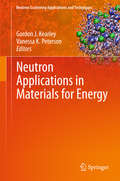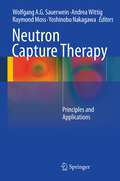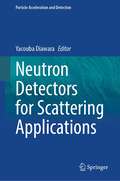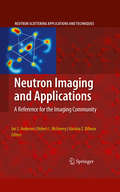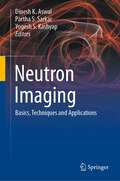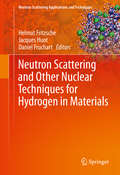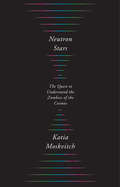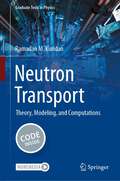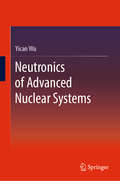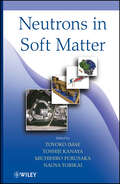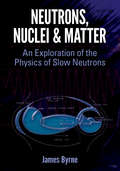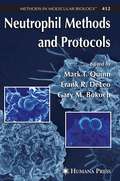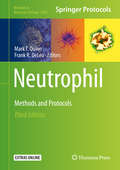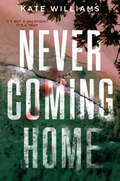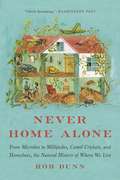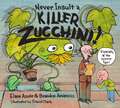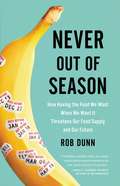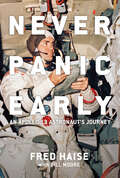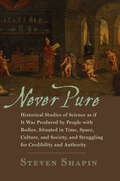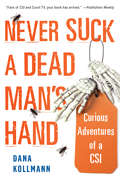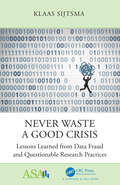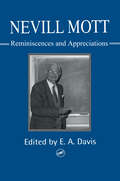- Table View
- List View
Neutron Applications in Materials for Energy
by Gordon J. Kearley Vanessa K. PetersonNeutron Applications in Materials for Energy collects results and conclusions of recent neutron-based investigations of materials that are important in the development of sustainable energy. Chapters are authored by leading scientists with hands-on experience in the field, providing overviews, recent highlights, and case-studies to illustrate the applicability of one or more neutron-based techniques of analysis. The theme follows energy production, storage, and use, but each chapter, or section, can also be read independently, with basic theory and instrumentation for neutron scattering being outlined in the introductory chapter. Whilst neutron scattering is extensively used to understand properties of condensed matter, neutron techniques are exceptionally-well suited to studying how the transport and binding of energy and charge-carrying molecules and ions are related to their dynamics and the material's crystal structure. These studies extend to in situ and in operando in some cases. The species of interest in leading energy-technologies include H2, H+, and Li+ which have particularly favourable neutron-scattering properties that render these techniques of analysis ideal for such studies and consequently, neutron-based analysis is common-place for hydrogen storage, fuel-cell, catalysis, and battery materials. Similar research into the functionality of solar cell, nuclear, and CO2 capture/storage materials rely on other unique aspects of neutron scattering and again show how structure and dynamics provide an understanding of the material stability and the binding and mobility of species of interest within these materials. Scientists and students looking for methods to help them understand the atomic-level mechanisms and behaviour underpinning the performance characteristics of energy materials will find Neutron Applications in Materials for Energy a valuable resource, whilst the wider audience of sustainable energy scientists, and newcomers to neutron scattering should find this a useful reference.
Neutron Capture Therapy
by Andrea Wittig Raymond Moss Wolfgang A.G. Sauerwein Yoshinobu NakagawaNeutron capture therapy (NCT) is based on the ability of the non-radioactive isotope boron-10 to capture thermal neutrons with very high probability and immediately to release heavy particles with a path length of one cell diameter, which in principle allows for tumor cell-selective high-LET particle radiotherapy. This book provides a comprehensive summary of the progress made in NCT in recent years. Individual sections cover all important aspects, including neutron sources, boron chemistry, drugs for NCT, dosimetry, and radiation biology. The use of NCT in a variety of malignancies and also some non-malignant diseases is extensively discussed. NCT is clearly shown to be a promising modality at the threshold of wider clinical application. All of the chapters are written by experienced specialists in language that will be readily understood by all participating disciplines.
Neutron Detectors for Scattering Applications (Particle Acceleration and Detection)
by Yacouba DiawaraThis book covers the most common neutron detectors used in neutron scattering facilities and all of those in use at Oak Ridge National Lab. It starts describing the facilities, instruments and the critical detector parameters needed by various instruments. Then the key components of the 3He-based linear position-sensitive detectors as well as on their electronics, which require particular attention to signal processing and noise reduction, are introduced. One chapter is dedicated to the 3He alternatives where scintillators play a critical role. It also covers emerging neutron detection technologies including semiconductors, vacuum-based devices and their associated readouts, which will be required in the future for high rate and high-resolution neutron detectors.The authors explain the logic behind the choice of materials as well as the various constraints that neutron detectors must respect to be useful. Some of these constraints, such as efficiency and gamma-ray sensitivity are common to all neutron counters while others, like timing resolution, dynamic range, and peak counting rate, depend on the applications.The book guides experts, the nuclear science community, and young scholars through the physical processes and the required electronics in a way that is accessible for those not professionally involved in designing detector’s components and electronic circuits.
Neutron Imaging and Applications
by Ian S. Anderson Robert Mcgreevy Hassina Z. BilheuxNeutron Imaging and Applications offers an introduction to the basics of neutron beam production in addition to the wide scope of techniques that enhance imaging application capabilities. An instructional overview of neutron sources, detectors, optics and spin-filters allows readers to delve more deeply into the discussions of radiography, tomography and prospective applications available in neutron holography techniques. A section devoted to current applications describes imaging single grains in polycrystalline materials, neutron imaging of geological materials and other materials science and engineering areas. Coverage of thermal neutron imaging of biological tissues, plant physiology, Homeland Security and contraband detection explore the future prospects of this cutting-edge research. Written by key experts in the field, researchers and engineers involved with imaging technologies will find Neutron Imaging and Applications a valuable reference.
Neutron Imaging: Basics, Techniques and Applications
by Dinesh K. Aswal Partha S. Sarkar Yogesh S. KashyapThis book comprehensively presents the concepts of neutron physics and imaging including neutron properties, neutron matter interaction, neutron imaging, comparison with X-ray and physics and design of neutron sources. It discusses how neutron imaging has gained importance as a powerful non-destructive technique to understand the internal structures of materials/engineered components in wide range of industries by increasing their applicability and efficiency. The book also covers the topics of neutron optics and detectors, basic principles of neutron radiography and tomography, related standards, safety, metrology and regulations in neutron imaging. The book presents applications of neutron imaging in the areas of aerospace industry, nuclear power and manufacturing industry, materials science and engineering, geomechanics, national security, biological, and medical domain. Given its scope, the book will be highly beneficial for postgraduate students, researchers and industry professionals working in the area of engineering and physics, especially non-destructive testing and non-destructive evaluation through neutron imaging.
Neutron Scattering and Other Nuclear Techniques for Hydrogen in Materials
by Jacques Huot Helmut Fritzsche Daniel FruchartThis book provides a comprehensive overview of the main nuclear characterization techniques used to study hydrogen absorption and desorption in materials. The various techniques (neutron scattering, nuclear magnetic resonance, ion-beams, positron annihilation spectroscopy) are explained in detail, and a variety of examples of recent research projects are given to show the unique advantage of these techniques to study hydrogen in materials. Most of these nuclear techniques require very specialized instrumentation, and there are only a handful of these instruments available worldwide. Therefore, the aim of this book is to reach out to a readership with a very diverse background in the physical sciences and engineering and a broad range of hydrogen-related research interests. The same technique can be used by researchers interested in the improvement of the performance of hydrogen storage materials and by those focused on hydrogen ingress causing embrittlement of metals. The emphasis of this book is to provide tutorial material on how to use nuclear characterization techniques for the investigation of hydrogen in materials - information that cannot readily be found in conference and regular research papers. Provides a comprehensive overview of nuclear techniques used for hydrogen-related research Explains all nuclear techniques in detail for the non-expert Covers the whole range of hydrogen-related research Features chapters written by world-renowned experts in nuclear technique and hydrogen-related research
Neutron Stars: The Quest To Understand The Zombies Of The Cosmos
by Katia MoskvitchThe astonishing science of neutron stars and the stories of the scientists who study them.Neutron stars are as bewildering as they are elusive. The remnants of exploded stellar giants, they are tiny, merely twenty kilometers across, and incredibly dense. One teaspoon of a neutron star would weigh several million tons. They can spin up to a thousand times per second, they possess the strongest magnetic fields known in nature, and they may be the source of the most powerful explosions in the universe. Through vivid storytelling and on-site reporting from observatories all over the world, Neutron Stars offers an engaging account of these still-mysterious objects.Award-winning science journalist Katia Moskvitch takes readers from the vast Atacama Desert to the arid plains of South Africa to visit the magnificent radio telescopes and brilliant scientists responsible for our knowledge of neutron stars. She recounts the exhilarating discoveries, frustrating disappointments, and heated controversies of the past several decades and explains cutting-edge research into such phenomena as colliding neutron stars and fast radio bursts: extremely powerful but ultra-short flashes in space that scientists are still struggling to understand. She also shows how neutron stars have advanced our broader understanding of the universe—shedding light on topics such as dark matter, black holes, general relativity, and the origins of heavy elements like gold and platinum—and how we might one day use these cosmic beacons to guide interstellar travel.With clarity and passion, Moskvitch describes what we are learning at the boundaries of astronomy, where stars have life beyond death.
Neutron Transport: Theory, Modeling, and Computations (Graduate Texts in Physics)
by Ramadan M. KuridanThis textbook provides a thorough explanation of the physical concepts and presents the general theory of different forms through approximations of the neutron transport processes in nuclear reactors and emphasize the numerical computing methods that lead to the prediction of neutron behavior. Detailed derivations and thorough discussions are the prominent features of this book unlike the brevity and conciseness which are the characteristic of most available textbooks on the subject where students find them difficult to follow. This conclusion has been reached from the experience gained through decades of teaching. The topics covered in this book are suitable for senior undergraduate and graduate students in the fields of nuclear engineering and physics. Other engineering and science students may find the construction and methodology of tackling problems as presented in this book appealing from which they can benefit in solving other problems numerically. The book provides access to a one dimensional, two energy group neutron diffusion program including a user manual, examples, and test problems for student practice. An option of a Matlab user interface is also available.
Neutronic Analysis For Nuclear Reactor Systems
by Bahman ZohuriThis expanded new edition develops the theory of nuclear reactors from the fundamentals of fission to the operating characteristics of modern reactors. The first half of the book emphasizes reactor criticality analysis and all of the fundamentals that go into modern calculations. Simplified one group diffusion theory models are presented and extended into sophisticated multi-group transport theory models. The second half of the book deals with the two main topics of interest related to operating reactors – reactor kinetics/dynamics, and in-core fuel management. Additional chapters have been added to expand and bring the material up-to-date and include the utilization of more computer codes. Code models and detailed data sets are provided along with example problems making this a useful text for students and researchers wishing to develop an understanding of nuclear power and its implementation in today’s modern energy spectrum.Covers the fundamentals of neutronic analysis for nuclear reactor systems to help understand nuclear reactor theory;Describes the benefits, uses, safety features, and challenges related to implementation of Small Modular Reactors;Provides examples, data sets, and code to assist the reader in obtaining mastery over the subjects.
Neutronics of Advanced Nuclear Systems
by Yican WuThis book provides a systematic and comprehensive introduction to the neutronics of advanced nuclear systems, covering all key aspects, from the fundamental theories and methodologies to a wide range of advanced nuclear system designs and experiments. It is the first-ever book focusing on the neutronics of advanced nuclear systems in the world.Compared with traditional nuclear systems, advanced nuclear systems are characterized by more complex geometry and nuclear physics, and pose new challenges in terms of neutronics. Based on the achievements and experiences of the author and his team over the past few decades, the book focuses on the neutronics characteristics of advanced nuclear systems and introduces novel neutron transport methodologies for complex systems, high-fidelity calculation software for nuclear design and safety evaluation, and high-intensity neutron source and technologies for neutronics experiments. At the same time, it describes the development of various neutronics designs for advanced nuclear systems, including neutronics design for ITER, CLEAR and FDS series reactors. The book not only summarizes the progress and achievements of the author’s research work, but also highlights the latest advances and investigates the forefront of the field and the road ahead.
Neutrons in Soft Matter
by Toyoko Imae Toshiji Kanaya Michihiro Furusaka Naoya TorikaiNeutron and synchrotron facilities, which are beyond the scale of the laboratory, and supported on a national level in countries throughout the world. These tools for probing micro- and nano-structure research and on fast dynamics research of atomic location in materials have been key in the development of new polymer-based materials. Different from several existing professional books on neutron science, this book focuses on theory, instrumentation, an applications. The book is divided into five parts: Part 1 describes the underlying theory of neutron scattering. Part 2 describes the various instruments that exist and the various techniques used to achieve neutron scattering or bombardment. Part 3 discusses data treatment and simulation methods as well as how to assess the environment of the sample (temperature, pressure, shear, and external fields). Part 4 addresses the myriad applications of small and large molecules, biomolecules, and gels. Part 5 describes the various global neutron sources that exist and provides an overview of the different reactors.
Neutrons, Nuclei and Matter: An Exploration of the Physics of Slow Neutrons (Dover Books on Physics)
by Dr James Byrne"A first-principles discussion of the fundamental neutron interactions . . . the writing is clear, and the explanations stress essential physical principles . . . an excellent survey."--Physics Today"A must for libraries of all universities and laboratories that are engaged in nuclear physics, particle physics, nuclear energy, astrophysics or condensed matter research . . . an outstanding multidisciplinary introduction to the physics and applications of cold neutrons."--Physics World"So many tables, facts and figures . . . the coverage is remarkable."--American ScientistThis encyclopedic reference work covers nearly every conceivable aspect of neutron physics. Assembled by an expert in the field, it ranges from the neutron's role as a major element in tests of the standard model of astro-particle physics to its use in nuclear energy generation and the study of condensed matter systems. The multidisciplinary approach includes detailed treatment of strong, weak, and electromagnetic properties of the neutron as well as parallel developments in cosmology and astrophysics. Each subject is placed within its scientific context and receives considerable attention to historical detail.
Neutrophil Methods and Protocols
by Gary M. Bokoch Frank R. Deleo Mark T. QuinnThis book provides a concise set of protocols for assessing basic neutrophil functions, investigating specialized areas in neutrophil research, and completing step-by-step diagnostic assays of common neutrophil disorders. Each of the protocols is written by leading researchers in the field and includes hints for success, as well as guidance for troubleshooting. Scientists and clinicians will find this collection an invaluable aid.
Neutrophil: Methods and Protocols (Methods in Molecular Biology #2087)
by Mark T. Quinn Frank R. DeLeoNeutrophils, the most abundant white cells in humans, serve as the primary cellular defense against infection. This volume provides a concise set of protocols for assessing basic neutrophil functions and investigating specialized areas in neutrophil biology. Each of the protocols is written by leading researchers in the field and includes hints for success, as well as guidance for troubleshooting. In the third edition of Neutrophils: Methods and Protocols, chapters retained from previous editions have been have been updated and include many new approaches. In addition, the Third Edition contains a number of new chapters that were not included in the first or second editions. Part I contains overviews of neutrophil biology, function, and disorders. Part II describes commonly used methods to isolate neutrophils from humans and other animal species. Part III details methods for investigating chemotaxis, transmigration, phagocytosis, and bactericidal activity. Part IV includes protocols that measure neutrophil apoptosis, calcium signal transduction, degranulation and detection of cytoplasmic granules, gene expression, transcription factors, and apoptosis. Part V provides multiple assays for measuring production of intracellular and/or extracellular reactive oxygen species, and a method that details use of the cell-free NADPH oxidase assay, an iconic assay for studies of the neutrophil NADPH oxidase. Part VI provides chapters that describe how to analyze formation and function of neutrophil extracellular traps. Neutrophil Methods and Protocols: Third Edition is a comprehensive source for detailed explanations and applications of the most modern methodological advances in neutrophil biology. Both basic scientists and clinicians will find a collection of this caliber to be an invaluable aid in their work with neutrophils.Features• Provides neutrophil protocols that are broadly applicable to leukocyte biology• Includes protocols for isolation of neutrophils from humans and animal species• Presents an interesting and informative overview of the field of neutrophil biology• Facilitates a better understanding of the role of neutrophils in host defenseReadershipMolecular and Cell Biologists, Immunologists, Infectious Disease Specialists, Microbiologists
Never Coming Home
by Kate M. WilliamsThe beach read you have been dying for! When ten of America's hottest teenage influencers are invited to an exclusive island resort, things are sure to get wild. But murder isn't what anyone expected. Will anyone survive?Everyone knows Unknown Island—it&’s the world&’s most exclusive destination. Think white sand beaches, turquoise seas, and luxury accommodations. Plus, it&’s invite only, no one over twenty-one allowed, and it&’s absolutely free. Who wouldn&’t want to go? The mysterious resort launched with a viral marketing campaign, and now the whole world is watching as the mysterious resort opens its doors to the First Ten, the ten elite influencers specifically chosen to be the first to experience everything Unknown Island has to offer. You know them. There&’s the gamer, the beauty blogger, the rich girl, the superstar, the junior politician, the environmentalist, the DJ, the CEO, the chef, and the athlete. What they don&’t know is that they weren&’t invited to Unknown Island for their following—they were invited for their secrets. Everyone is hiding a deadly one, and it looks like someone&’s decided it&’s payback time. Unknown Island isn&’t a vacation, it&’s a trap. And it&’s beginning to look like the First Ten—no matter how influential—are never coming home.
Never Home Alone: From Microbes to Millipedes, Camel Crickets, and Honeybees, the Natural History of Where We Live
by Rob DunnA natural history of the wilderness in our homes, from the microbes in our showers to the crickets in our basements <P><P>Even when the floors are sparkling clean and the house seems silent, our domestic domain is wild beyond imagination. In Never Home Alone, biologist Rob Dunn introduces us to the nearly 200,000 species living with us in our own homes, from the Egyptian meal moths in our cupboards and camel crickets in our basements to the lactobacillus lounging on our kitchen counters. You are not alone. <P><P>Yet, as we obsess over sterilizing our homes and separating our spaces from nature, we are unwittingly cultivating an entirely new playground for evolution. These changes are reshaping the organisms that live with us--prompting some to become more dangerous, while undermining those species that benefit our bodies or help us keep more threatening organisms at bay. <P><P>No one who reads this engrossing, revelatory book will look at their homes in the same way again.
Never Insult a Killer Zucchini
by Elana Azose Brandon AmancioThis is one science fair you&’ll never forget! When Mr. Farnsworth, the science-fair judge, declares that he loves zucchinis, the Killer Zucchini is smitten. As the judge makes his way through the exhibits alphabetically—A (antimatter), B (bionic limb), C (cloning)—the Killer Zucchini tries to show his affection. But when Mr. F gets to K and admits he likes to eat zucchini with ranch dressing, the Killer Zucchini gets steamed and attempts to exact his revenge on the snack-loving judge using the other science-fair projects as his means to an end. Hilarious havoc ensues as the entire science fair is destroyed by his wrath. Engaging backmatter provides the science behind the science fair entries created by the characters in the story.
Never Out of Season: How Having the Food We Want When We Want It Threatens Our Food Supply and Our Future
by Rob DunnA Fast Food Nation for the foods we grow and depend onThe bananas we eat today aren't your parents' bananas: We eat a recognizable, consistent breakfast fruit that was standardized in the 1960s from dozens into one basic banana. But because of that, the banana we love is dangerously susceptible to a pathogen that might wipe them out.That's the story of our food today: Modern science has brought us produce in perpetual abundance-once-rare fruits are seemingly never out of season, and we breed and clone the hardiest, best-tasting varieties of the crops we rely on most. As a result, a smaller proportion of people on earth go hungry today than at any other moment in the last thousand years, and the streamlining of our food supply guarantees that the food we buy, from bananas to coffee to wheat, tastes the same every single time.Our corporate food system has nearly perfected the process of turning sunlight, water and nutrients into food. But our crops themselves remain susceptible to the nature's fury. And nature always wins.Authoritative, urgent, and filled with fascinating heroes and villains from around the world, Never Out of Season is the story of the crops we depend on most and the scientists racing to preserve the diversity of life, in order to save our food supply, and us.
Never Panic Early: An Apollo 13 Astronaut's Journey
by Fred Haise Bill MooreThe extraordinary autobiography of astronaut Fred Haise, one of only 24 men to fly to the moonIn the gripping Never Panic Early, Fred Haise, Lunar Module Pilot for Apollo 13, offers a detailed firsthand account of when disaster struck three days into his mission to the moon. An oxygen tank exploded, a crewmate uttered the now iconic words, &“Houston, we&’ve had a problem here,&” and the world anxiously watched as one of history&’s most incredible rescue missions unfolded. Haise brings readers into the heart of his experience on the challenging mission--considered NASA&’s finest hour--and reflects on his life and career as an Apollo astronaut. In this personal and illuminating memoir, illustrated with black-and-white photographs, Haise takes an introspective look at the thrills and triumphs, regrets and disappointments, and lessons that defined his career, including his years as a military fighter pilot and his successful 20-year NASA career that would have made him the sixth man on the moon had Apollo 13 gone right. Many of his stories navigate fear, hope, and resilience, like when he crashed while ferrying a World War II air show aircraft and suffered second and third-degree burns over 65 percent of his body, putting him in critical condition for ten days before making a heroic recovery. In Never Panic Early, Haise explores what it was like to work for NASA in its glory years and demonstrates a true ability to deal with the unexpected.
Never Pure: Historical Studies of Science as if It Was Produced by People with Bodies, Situated in Time, Space, Culture, and Society, and Struggling for Credibility and Authority
by Steven ShapinSteven Shapin argues that science, for all its immense authority and power, is and always has been a human endeavor, subject to human capacities and limits. Put simply, science has never been pure. To be human is to err, and we understand science better when we recognize it as the laborious achievement of fallible, imperfect, and historically situated human beings.Shapin’s essays collected here include reflections on the historical relationships between science and common sense, between science and modernity, and between science and the moral order. They explore the relevance of physical and social settings in the making of scientific knowledge, the methods appropriate to understanding science historically, dietetics as a compelling site for historical inquiry, the identity of those who have made scientific knowledge, and the means by which science has acquired credibility and authority.This wide-ranging and intensely interdisciplinary collection by one of the most distinguished historians and sociologists of science represents some of the leading edges of change in the scholarly understanding of science over the past several decades.
Never Smoke Again: The Top 10 Ways to Stop Now & Forever
by Grant CooperIt isn't easy to stop smoking. Yet according to the American Lung Association, well over 45 million Americans have already quit. How did they do it? They found the method that worked for them and they stuck to it. Often, it wasn't the first method they tried. In fact, most smokers attempt to quit several times before they are successful--before they find the technique that works for them. This book can help you find the method that's right for you so that you never smoke again. Never Smoke Again begins by taking a long, hard look at cigarettes, at why you smoke them, and at how they keep you coming back for more--even when you want desperately to toss them away. It then presents ten chapters, each of which focuses on one of the top ten techniques for quitting smoking: * COLD TURKEY * TAPERING OFF * NICOTINE PATCH * NICOTINE GUM * NICOTINE LOZENGES * NICOTINE NASAL SPRAY * NICOTINE INHALER * ZYBAN * CHANTIX * HYPNOSIS For each stop-smoking method, you'll discover what the method is, how it works, how you can best use it, what its risks and drawbacks are, and how effective it is compared with other available techniques. Special Pros and Cons sections highlight the important features of each method, making it easier to pick the tool or tools that are most suited to your needs. A Resources list guides you to organizations that can provide further information and support, rounding out your arsenal of anti-smoking weapons. You have within you the strength and resolve needed to kick the smoking habit forever. Never Smoke Again will show you how to access that power, team it up with a proven quitting technique, and begin a new, healthy, cigarette-free life.
Never Suck A Dead Man's Hand: Curious Adventures Of A Csi (Crime Scene Ser.)
by Dana Kollmann&“Informative, witty . . . Kollmann delivers terse commentary and gory detail while puncturing common misconceptions about forensics.&” —Booklist Step past the flashing lights into the true scene of the crime with this frank, unflinching, and unforgettable account of life as a crime scene investigator. Whether explaining rigor mortis or the art of fingerprinting a stiff corpse on the side of the road, Dana Kollmann details her true, unvarnished experiences as a CSI for the Baltimore County Police Department. &“Riveting.&” —M. William Phelps, New York Times bestselling author of We Thought We Knew You Unlike the popular crime dramas proliferating on today&’s television networks, these forensic tales forgo glitz for grit to show what really goes on. Kollmann recounts stories that the cops and the CSI&’s usually leave in the field, bringing the sights, smells, and sounds of a crime scene alive as never before. &“Raw and real.&” —Connie Fletcher, author of Every Contact Leaves a Trace Unveiling the process and science of crime scene investigation in all its can&’t-tear-your-eyes-away fascination, Never Suck a Dead Man&’s Hand takes you into the strange world behind the yellow tape, offering a truly eye-opening perspective on the day-to-day life of a CSI. &“Gritty, witty, and heartfelt . . . a must-read.&” —Aphrodite Jones, New York Times bestselling author of A Perfect Husband
Never Waste a Good Crisis: Lessons Learned from Data Fraud and Questionable Research Practices (ASA-CRC Series on Statistical Reasoning in Science and Society)
by Klaas SijtsmaThis book covers statistical consequences of breaches of research integrity such as fabrication and falsification of data, and researcher glitches summarized as questionable research practices. It is unique in that it discusses how unwarranted data manipulation harms research results and that questionable research practices are often caused by researchers’ inadequate mastery of the statistical methods and procedures they use for their data analysis. The author’s solution to prevent problems concerning the trustworthiness of research results, no matter how they originated, is to publish data in publicly available repositories and encourage researchers not trained as statisticians not to overestimate their statistical skills and resort to professional support from statisticians or methodologists.The author discusses some of his experiences concerning mutual trust, fear of repercussions, and the bystander effect as conditions limiting revelation of colleagues’ possible integrity breaches. He explains why people are unable to mimic real data and why data fabrication using statistical models stills falls short of credibility. Confirmatory and exploratory research and the usefulness of preregistration, and the counter-intuitivenature of statistics, are discussed.The author questions the usefulness of statistical advice concerning frequentist hypothesis testing, Bayes-factor use, alternative statistics education, and reduction of situational disturbances like performance pressure, as stand-alone means to reduce questionable research practices when researchers lack experience with statistics.An interview with the author can be found here: https://www.tilburguniversity.edu/magazine/overview/former-rector-sijtsma-turn-statistician-fight-fraud-and-sloppiness.
Never at Rest
by Richard S. WestfallThis richly detailed 1981 biography captures both the personal life and the scientific career of Isaac Newton, presenting a fully rounded picture of Newton the man, the scientist, the philosopher, the theologian, and the public figure. Professor Westfall treats all aspects of Newton's career, but his account centres on a full description of Newton's achievements in science. Thus the core of the work describes the development of the calculus, the experimentation that altered the direction of the science of optics, and especially the investigations in celestial dynamics that led to the law of universal gravitation.
Nevill Mott: Reminiscences And Appreciations
by E. A. DavisSir Nevill Mott was Britain's last Winner of the Nobel Prize for Physics. This is a tribute to the life and work of Nobel Laureate Nevill Mott, a hugely admired and appreciated man, and one of this countries greatest ever scientists. It includes contributions from over 80 of his friends, family and colleagues, full of anecdotes and appreciations for this collossus of modern physics.
